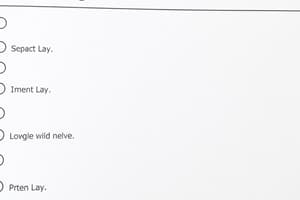Podcast
Questions and Answers
What is the best way to avoid bias in surveys?
What is the best way to avoid bias in surveys?
- Use random sampling techniques (correct)
- Use convenience sampling techniques
- Use self-selected sampling techniques
- Use quota sampling techniques
What should you do if you suspect bias in your data?
What should you do if you suspect bias in your data?
- Double check your work and consider having someone else look it over (correct)
- Exclude the biased data from the analysis
- Increase the weight of the biased data in the analysis
- Ignore the bias and proceed with the analysis
Why are results from a biased dataset considered worse than no results at all?
Why are results from a biased dataset considered worse than no results at all?
- Biased results are harder to present
- Biased results are harder to analyze
- Biased results are less interesting
- Biased results can lead to incorrect conclusions and decisions (correct)
Why does marketing analytics rely almost exclusively on sampling?
Why does marketing analytics rely almost exclusively on sampling?
What is the purpose of carefully selecting a sample population in marketing analysis?
What is the purpose of carefully selecting a sample population in marketing analysis?
What is the consequence of bias in marketing analysis?
What is the consequence of bias in marketing analysis?
Why is it usually impossible to survey every possible customer in marketing studies?
Why is it usually impossible to survey every possible customer in marketing studies?
What factor can skew survey results due to people's inability to accurately remember past events?
What factor can skew survey results due to people's inability to accurately remember past events?
How can order bias be mitigated in surveys?
How can order bias be mitigated in surveys?
What can influence survey outcomes and should be carefully reviewed to avoid bias?
What can influence survey outcomes and should be carefully reviewed to avoid bias?
What bias can be addressed by involving local individuals in survey administration and translation?
What bias can be addressed by involving local individuals in survey administration and translation?
What can lead people to seek out evidence that supports their existing beliefs, and can affect survey results?
What can lead people to seek out evidence that supports their existing beliefs, and can affect survey results?
How can confirmation bias be minimized in survey analysis?
How can confirmation bias be minimized in survey analysis?
What bias occurs when participants alter their behavior due to being watched, leading to skewed results?
What bias occurs when participants alter their behavior due to being watched, leading to skewed results?
How can observation bias be mitigated in surveys?
How can observation bias be mitigated in surveys?
What occurs when the sample of survey participants does not represent the whole target population?
What occurs when the sample of survey participants does not represent the whole target population?
How can selection bias be minimized in surveys?
How can selection bias be minimized in surveys?
What can be minimized by using short, specific, and multiple-choice questions about the past?
What can be minimized by using short, specific, and multiple-choice questions about the past?
How can culture bias be addressed in surveys?
How can culture bias be addressed in surveys?
Flashcards
Avoiding bias in surveys
Avoiding bias in surveys
Using random sampling techniques to get a fair, unbiased representation of the population.
Suspecting bias in data
Suspecting bias in data
When you notice something might be skewed, double-check your work and get a second opinion from others.
Biased dataset results
Biased dataset results
They're worse than no results because they can lead to incorrect conclusions and choices.
Marketing analytics sampling
Marketing analytics sampling
Signup and view all the flashcards
Sample population selection
Sample population selection
Signup and view all the flashcards
Bias in marketing analysis
Bias in marketing analysis
Signup and view all the flashcards
Surveying every customer
Surveying every customer
Signup and view all the flashcards
Recall bias
Recall bias
Signup and view all the flashcards
Order bias mitigation
Order bias mitigation
Signup and view all the flashcards
Leading questions
Leading questions
Signup and view all the flashcards
Culture bias
Culture bias
Signup and view all the flashcards
Confirmation bias
Confirmation bias
Signup and view all the flashcards
Minimizing confirmation bias
Minimizing confirmation bias
Signup and view all the flashcards
Observation bias
Observation bias
Signup and view all the flashcards
Mitigation of observation bias
Mitigation of observation bias
Signup and view all the flashcards
Selection bias
Selection bias
Signup and view all the flashcards
Minimizing selection bias
Minimizing selection bias
Signup and view all the flashcards
Minimizing recall bias
Minimizing recall bias
Signup and view all the flashcards
Addressing culture bias
Addressing culture bias
Signup and view all the flashcards
Study Notes
Common Biases in Surveys and How to Avoid Them
- Survey bias can occur due to factors like order bias, leading questions, and recall bias, which can skew survey results.
- Order bias can be mitigated by randomizing the order of questions or answers in survey software.
- Leading questions can influence outcomes and should be carefully reviewed to avoid bias.
- Recall bias is due to people's inability to accurately remember past events, and can be minimized by using short, specific, and multiple-choice questions about the past.
- Culture bias arises from different cultural perspectives and can be addressed by involving local individuals in survey administration and translation.
- Localization groups can ensure that survey data is appropriate for specific cultural areas.
- Confirmation bias leads people to seek out evidence that supports their existing beliefs, and can affect survey results.
- To minimize confirmation bias, analysts should approach surveys with an open mind and healthy skepticism.
- Observation bias occurs when participants alter their behavior due to being watched, leading to skewed results.
- Informal approaches and assurance of data anonymization can help mitigate observation bias.
- Selection bias occurs when the sample of survey participants does not represent the whole target population.
- It is essential to ensure that the selection of survey participants is not biased and favors subsets of the general population.
Studying That Suits You
Use AI to generate personalized quizzes and flashcards to suit your learning preferences.




